| Srl | Item |
| 1 |
ID:
175883
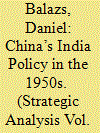

|
|
|
|
|
| Summary/Abstract |
What led to the Sino-Indian militarized confrontations in 1959? I argue that Hindi-Chini Bhai-Bhai became a victim of changed perceptions in China. As long as China’s external and internal environment was relatively secure, India was seen as a potential ally, and Sino-Indian relations thrived. As external and internal pressures on China mounted, India’s behaviour vis-à-vis the Dalai Lama’s flight from China and the territorial dispute was perceived by China as reactionary. This change in perceptions prevented Beijing from adopting a conciliatory approach to India’s claims and eventually led to the 1962 border war.
|
|
|
|
|
|
|
|
|
|
|
|
|
|
|
|
| 2 |
ID:
175884
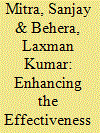

|
|
|
|
|
| Summary/Abstract |
Post-COVID, the renewed emphasis on indigenisation in India calls for a fresh, in-depth examination of the entire range of issues and policies pertaining to the development of a capable domestic base for the defence industry and technology. This study opens up the field of inquiry, first, by adapting the well-known Delphi method for the indigenous development and manufacture of bullet-proof jackets and then in trying to examine all the elements of the decision-making process—from framing requirements by the armed forces to final procurement by the government, through an elaborately structured, multi-stakeholder consultative process. The approach can possibly be tailored to examine more complex systems that require indigenisation.
|
|
|
|
|
|
|
|
|
|
|
|
|
|
|
|
| 3 |
ID:
175882
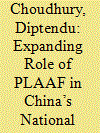

|
|
|
|
|
| Summary/Abstract |
China’s great power ambition and actions have been fuelled by its spectacular economic growth and military modernization. The need to sustain the economy and energy flow makes the East and South China seas vital to it. Its vulnerabilities also lie on its seaboard. To dominate the maritime spaces, it needs to own the contiguous airspace as well. The prescient Chinese leadership has transformed its Air Force into a strategic instrument of power, to protect its economic lifelines, geo-political interests and regional dominance. An analysis of the PLAAF’s transformation and its employment philosophy provides insights into how it has leveraged airpower for furthering its strategic interests.
|
|
|
|
|
|
|
|
|
|
|
|
|
|
|
|
| 4 |
ID:
175886
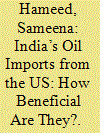

|
|
|
|
|
| Summary/Abstract |
India has been importing oil from the US to diversify away from the Middle Eastern Crudes. However, the weak oil demand, with attendant supply glut and contest for market share are reshaping global energy politics. This article examines the extent to which increasing oil imports from the US would be conducive for India's energy needs and the possible trade-off for the Indian refineries.
|
|
|
|
|
|
|
|
|
|
|
|
|
|
|
|
| 5 |
ID:
175885


|
|
|
|
|
| Summary/Abstract |
Iran—US relations are in a state of flux due to President Trump’s draconian sanctions, what is dubbed the ‘maximum pressure’ campaign, to force Iran to renegotiate the 2015 nuclear deal. Iran’s ‘counter pressure’ policy, in contrast, has sought to blunt the effects of sanctions and compel the Trump administration to return to the nuclear deal. This article examines the basic thrust, goals and shortcomings of Trump’s anti-Iran campaign, and also explores Iran’s policy choices and responses to face off Trump’s campaign of ‘maximum pressure’. The prospect of slow death under sanctions and recent changes in Iran’s domestic power equations in favour of the hardliners is potentially paving the way for Iran for a war decision to permanently free itself from the suffocating shackles of US sanctions.
|
|
|
|
|
|
|
|
|
|
|
|
|
|
|
|
| 6 |
ID:
175887
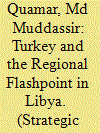

|
|
|